
The Natural Georgia Series: Atlanta's Urban Wildlife

 |
The Natural Georgia Series: Atlanta's Urban Wildlife |
 |
Urban plant species must present certain characteristics that allow them to survive in disturbed environments. They are usually hardy and aggressive, and their seeds spread easily by wind, birds, or other mammals.
In addition to those listed, other abundant urban plantlife includes Kudzu, White Oak and Crepe Myrtle trees, and a wide variety of understory species. These plants thrive in Georgia's warm climates, but they can accept the occasional freezing temperatures that sometimes occur. They enjoy plentiful rainfall and can easily adapt to conditions common to Georgia's topography, which exhibits reddish, dense, low-oxygen, high-mineral soil and nearly eroded topsoil.
Because Georgia's temperatures are warmer than those of northern states, botanic wildlife as a general rule tends to flourish more easily. Survival is based on flexibility and reproduction—meaning that a plant's ability to adjust to diverse soil and quickly reseed itself aids in easier adaptability than those plants that depend on more restricted soil types to survive. In addition, reproduction of many urban plants depends on the prevalence of birds and other mammals, creating a symbiotic relationship between flora and fauna.
One of the largest southern pines, the Pinus taeda often reaches 90 to 100 feet in height and 2 to 3 feet in circumference. It is the most prevalent evergreen pine noted in urban areas, although it inhabits the entire state. Mature needles are about 6 to 9 inches long. Both male and female young cones are yellow; however, the small males are crowded in short spikes at the end of the branches. Female Loblolly cones are larger and occur as single cones. Sometimes mistaken for the Slash Pine, closer examination of the Loblolly Pine reveals its more dull brown and sharp-prickled cones. This tree easily moves into poor quality, eroded areas, as if to reclaim the land. Perhaps this characteristic is the reason for its nickname, Oldfield Pine. This pine comprises nearly all of the timber gathered in the Piedmont, and the wood is valuable lumber, construction timber pulp, and plywood. Because it grows rapidly at a young age, it is the primary tree used in reforestation programs.
This autumn wildflower is abundantly produced in urban as well as rural environments throughout the state. Goldenrod, of the Sunflower family, Asteraceae, is an herbaceous perennial that commonly blooms along with groundsel bush, ragweed, ironweed, wild aster, and many other wildflowers. This plant begins from a low clump of foliage in the late spring to early summer and grows as a stiff and erect, numerously branched stem.
Propagated by seeds, leaflets are coarse-textured and densely covered with tiny, stiff hairs. Because it thrives in full sunlight and is tolerant of most soil conditions, goldenrod and many other species of wildflowers are commonly cultivated along roadsides and open medians. Although goldenrod pollen is not transferred by wind, it is the assumed culprit of hayfever because it is found amidst ragweed—the true culprit. Goldenrod's sweet nectar attracts many insects, especially butterflies.
An aggressive vine, Rhus radicans usually clings to tree trunks and other irregular surfaces, spreading by aerial rootlets, although its growth pattern is sometimes almost shrublike. Though it is familiar to many for its poisonous effect, it is valuable to wildlife. Mature plants produce creamy white, almost pale yellow berries, supplying food for birds and small animals. When berries have matured in the late fall, the green foliage gives way to more captivating, bright orange-red leaves. Spreading by suckers and seeds, the vine is openly dense, and the leaves are extremely coarse textured. Though the plant consistently produces three leaflets, their size and shape vary greatly and can sometimes be confused with other nearby vines. Therefore, it is safer for nonexperts to remember the saying,"leaves of three, let it be."
 Blackberry
Blackberry
This shrub of the genus Rubus often occurs in open, naturalistic settings and is predominantly found in suburban areas or on the edges of forests. Its heavily prickled stems grow upright or slightly arching. The foliage commonly has five leaflets, and the leaves are clustered in fan shapes. The blackberry shrub produces beautiful white flowers seasonally in late spring to midsummer. Its namesake fruit doesn't appear until late July through early fall. The berries, at first glance, appear black but are actually deep, rich purple, and they are a nutritional food source for many birds and small animals. Because of their sweetness, these berries have long since been discovered by Southerners and are commonplace in many recipes.
Aster species, belonging to sunflower family, Asteraceae, each are uniquely beautiful with varying colors, ranging from soft yellow and white, to bright blue and lavender. Appearing regal and confident at heights of 3 to 5 feet, these wildflowers are irresistible to humans and are often found adorning tabletops. They are predominantly found in thickets, wastelands, and roadsides, and they easily spread into old abandoned fields. An abundance of asters signal that cooler temperatures are on the way.
Occasionally achieving tree size, this shrub is commonly found throughout the state, including urban areas. Sambucus canadensis, often called elderberry, flourishes on wet or moist sites and usually occupies stream land, bottomlands, or the edges of fields and forests. It produces delightful flowers in early to midsummer that form abundant clusters over the shrub's entire crown. Although they are aesthetically pleasing, elderberries have limited ornamental uses because of their expansive growth potential. Maturing in late summer through early autumn, the purplish-black elderberry fruit droops in clusters from thin branches. Slightly sweet, juicy berries allure songbirds, insects, game, and other small mammals, but this delightful fruit is also used in jellies, pies, and wine.
Often reaching heights of 2 to 3 feet at full maturity, Andropogon capillies is a rather tall, tufted grass prevalent in many moist, open areas and lowlands. Over 20 species exist in various parts of Georgia; however, they are not easily distinguishable. This abundant grass has the potential to become unkempt; however, it can be controlled by mowing and proper field maintenance.
This member of the maple family prospers in varied soil types and usually reaches 60 to 90 feet in height and 2 to 3 feet in diameter. Acer rubrum is deciduous, and its blades are variable in shape. As a young tree, its light gray, smooth bark identifies it as a maple. During the fall, Red Maple leaves brilliantly exhibit a deep, rich, red pigment that makes it a favorite ornamental tree. Relatively disease- and insect-free foliage increases the tree's popularity. Prior to autumn, bright flowers and fruit adorn maple branches.
Widely recognized as a southern staple, particularly in urban Georgia, is the Cornus florida, or flowering dogwood. Though many Cornus species are shrubs, the florida can reach heights of 20 to 40 feet, allowing it to magnificently dominate outdoor beauty. With large, glowing white, petal-like bracts encompassing yellowish-green flowers, these small trees demand admirers. Though dogwoods are a common ornamental tree, they exist naturally throughout the entire state. An occasional pink dogwood will naturalize; however, most are hybrids, like the white-pink and red versions. The dogwood adorns parks, neighborhoods, and backyards and even lines Atlanta highways. Its successful survival in urban conditions is attributed to two factors: its extremely heavy wood and its ability to adapt to various soil types. While the floral beauty can be enjoyed in the spring and summer, fall and winter bring forth distinguishable bright red fruit, which serves as a significant food source for other wildlife.
Atlanta and surrounding suburban counties are home to nearly 10 percent of the 956 vertebrate species found in Georgia, according to Todd Schneider, wildlife biologist for the nongame division of the Georgia Department of Natural Resources. Generally, these animals are found close by deciduous forests and waters, such as the Fernbank or Chattahoochee forests. But while these animals appreciate an abundance of natural forage, they will travel great distances for food.
The common denominator among urban fauna is their ability to adjust to ever-changing disturbed conditions. Most of these animals have extremely flexible eating habits and are rarely intimidated by man. In many cases, as the population increases, so do the food sources and potential nesting sites for these animals.
Another reason for their survival is the near elimination of predators, like the fox. Most of these predators are skittish around humans and are easily threatened by day-to-day congestion. They are also intolerable of disturbed environments, preferring more natural, rural habitats. While man is a continuous threat to some species, many are natural self-preservationists—either through their more frequent breeding or their aggressive and shrewd defensive behavior. These factors, coupled with Georgia's warmer climate and fairly abundant forestry, support urban wildlife.
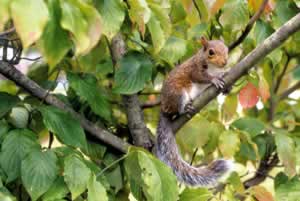 Gray
Squirrel
Gray
Squirrel Probably the most common and well-adapted urban mammal is the Sciurus carolinesis. This adaptability is attributed to three factors: flexible living conditions and food sources; a scarcity of predators such as hawks; and lastly, nonskittish behavior around humans. If offered food, they often times will eat directly from a human hand. Despite their sometimes nuisance behavior, humans remain quite tolerable of squirrels, and in fact, they are a favorite wildlife creature for some people. Animal behaviorists have suggested that this is due largely to the squirrel's vulnerable and babylike appearance.
Undoubtedly squirrels are fascinating, and their active diurnal lifestyle calls the attention of many. Depending largely on nuts, fruits, and seeds for food, these small animals gather around nearby woodlands. Preferring hardwood remnants, these omnivorous mammals will consume bird eggs and on rare occasions, small birds. Gray squirrels spend waking hours gathering and transporting food for the winter months but sleep in den trees and temporary leaf nests. Den trees are most beneficial as they can be used for reproduction, shelter, and escape from danger. Gray Squirrels generally breed in mid-January and early June, with gestation lasting about 42 to 45 days. These animals will produce an average litter of two, maybe three young.
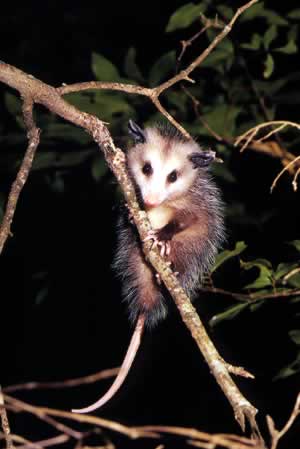 Opossum
Opossum
Committed to the warmth of the south, these medium-sized mammals roam deciduous suburban areas in constant search of food. Didelphis virginiana is actively nocturnal and makes its daytime bed in a ground den. Like squirrels, these creatures are omnivorous and rarely exhibit the scavenging habits of their Norway Rat relatives. Most opossums have gray fur, and all have extremely coarse hair, naked ears, and a long, nearly naked tail. The largest male can weigh about 13 pounds, with females averaging about 10 pounds.
When necessary, an Opossum can support its own weight by wrapping its amazingly strong and dextrous tail around a stable object, such as a tree limb. Also surprising to many is its true timid nature. When it senses danger, this unique creature will display a catatonic behavior, termed "playing possum." The opossum will remain in that state for over an hour to ensure danger has passed. Opossums produce about 24 young per breeding season, allowing them to remain populated despite their relatively short lives. Opossums generally do not survive longer than a year or two. It is not that they cannot live long lives, but that they become easy targets for predators upon initial separation from their mother. The young are fed and nurtured inside the mother's pouch for nearly eight weeks, and they become independent around three months old.
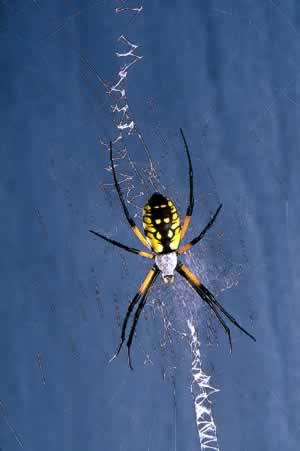 Black-And-Yellow
Argiope
Black-And-Yellow
Argiope Drawn to the sunny south, the Argiope aurantia usually has a yellow and black body, with black legs encompassed by red or yellow bands near the body. Most other argiope species are restricted to more southern extremes and into Mexico. Preferring almost stagnant environments, the Black-And-Yellow Argiope will drop to the ground and hide if disturbed by high winds or other dangers. Its feeding habits are similar to those of most spiders, dining on flying insects trapped in its spiral-like web. Webs are generally formed in shrubbery and tall plants and flowers. Young argiopes are hatched in the fall and they nest until spring before dispersing.
Because Procyon lotor greatly depends on humans, it continues to flourish in urban environments. Raccoons' curious nature and banditlike faces win the admiration of all who get a glimpse of these nocturnal creatures. The breeding season extends from February to August, and the average number of young born is three. With gestation lasting about 63 days, the litter is typically born from April to October. At full maturity, a male Raccoon weighs around 13 pounds and is 2 to 3 feet long; females are slightly smaller.
Raccoons will eat nearly anything, including fruits, nuts, small fish, vegetables, and small mammals. Like opossums, they are constantly searching for food. Unlike squirrels and chipmunks, they do not depend on gathering food for winter. Instead, they gorge themselves to add significant body weight and fat reserves for colder temperatures. Raccoon dens are generally above ground in tree cavities but are sometimes found in chimneys and attics. Raccoons have been known to burrow underground, a technique similar to chipmunks.
A boldly aggressive blue bird, the southern Cyanocitta cristata is a survivor and is an easy match for tough urban environments. Interestingly, its northern relatives do not display these same behaviors and are more commonly found in deep woods, almost hiding from man. Though Blue Jays are well known, they are outnumbered by starlings. Aggressive behavior clearly extends to the Blue Jay's feeding habits, and these blue omnivores have been known to attack and consume other young birds. However, Blue Jays primarily eat nuts, fruits, seeds, worms, and insects. Contrasting sharply with its attitude is the Blue Jay's superficial beauty. It has bold white spots on the wings and tail and an obvious distinguishable crest. Its intense pigment and quick actions beautifully complement an otherwise quiet background. Relatively inconspicuous in the spring, the Blue Jay is busy raising its young.
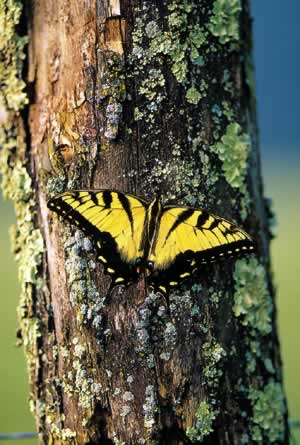 Tiger
Swallowtail
Tiger
Swallowtail Popilio glaucus linnaeus has an affection for urban environments that allows it to outnumber most species. Though Tiger Swallowtails are also quite famous in northern states, Georgia's warmer seasons have allowed them to flourish. About 70 percent of the males are predominantly dark brown, while the remainder share a unique shade of yellow with the females. Like most butterflies, the Tiger Swallowtail is hopelessly attracted to flower gardens, but these strong wind-sailors frequent close-by woodlands and city parks.
Probably the most common bird inhabiting urban skies, the Sturnus vulgaris has been around since it was introduced in 1890. In fact, there are tens of thousands that either reside or migrate here. The Starling is very distinctive, initially exhibiting a stout blackbird appearance. However, upon closer examination, it appears almost iridescent purple and green. Its long bill changes from a dull brown in the winter to yellow in the spring.
A Starling's diet consists of many fruit and nut varieties, but it much prefers brightly colored fragrant sweeter fruits, such as cherries. Because it also consumes a large number of insects, it is beneficial to mankind. A gregarious creature, the starling is always on the move, looking for open fields to feed in. This bird is not one seen in more heavily canopied wooded areas like the Chattahoochee forests; it prefers more disturbed environments. One interesting fact: unlike many birds, the Starling nest is never constructed in the open, but rather in a cavity. Nests are built from weed stems, coarse grasses, bark, and pine needles.
There are three known species of the genus Corvus found in Georgia, the Eastern Common Crow, Corvus brachyrhynchos; the Southern Common Crow, Corvus brachyrhynchos paulus; and the Fish Crow, Corvus ossibragus. Of these three, the most prevalent is the Southern Common Crow, with the Fish Crow restricted to the coastal areas of the state. Like the Starling, the Southern Common Crow has resided in Georgia since the 1920s; however, it is much less plentiful. The Southern Common Crow needs little introduction due to its widely recognized black appearance and large stature. Because of its hardy stature and shrewd nature, it has persevered the most difficult of environments. This highly omnivorous creature naturally exists in woodlands, farmlands, agricultural fields, and river groves.
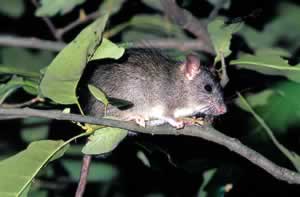 Norway
Rat
Norway
Rat This large nocturnal rat is found throughout the entire state, including the Coastal Plain and some mountain regions, but it flourishes in the more densely populated Piedmont, where food and shelter are abundant. The adult Rattus norvegicus has a long, naked tail and coarse-textured, almost wiry, short, brownish hair, and it weighs between 10 and 16 ounces. Introduced in the mid 1700s, Norway Rats are believed to have conquered the territory of their relative, the Black Rat. As a result, Black Rats are more prevalent in coastal and rural areas.
Highly omnivorous Norway Rats gather in alleys and small parks where they are most likely to find leftover food. Norway rats are capable of breeding year-round and usually produce five litters of 8 to 12 young per year. Despite their large size, determined rats can enter tiny holes and will even use rather intricate pipe systems to go from one place to another. Norway Rats prefer to live in burrows, but they will go anywhere human clutter collects and will travel far from home to reach a single food source. Unusual sounds in the walls or attic, gnawed holes, and small droppings are good indications of their presence. The best way to deter these creatures from domestic invasion is to practice proper sanitation, including storing bird seed and other animal feed in airtight containers and storing garbage in tightly closed receptacles.
 Robin
Robin
Of three species of the genus Turdus—the Eastern Robin, Turdus migratorius; the Southern Robin, Turdus migratorius achrusterus; and the Newfoundland Robin, Turdus migratorius nigrideus—the latter is the only permanent inhabitant of Georgia. Usually recognized confidently walking the streets and sidewalks, the robin is identified by its gray back and brick-red breast. Blackish heads and tails are reserved for males, while the female is gray. Breeding normally occurs twice and sometimes three times per year, and fresh, light-blue eggs can be found from April through August. Like the Starling, robins tend to prefer urban environments, and next to pigeons, are probably most prevalent in downtown areas. Their preference for these conditions is largely due to their flexible eating and nesting habits.
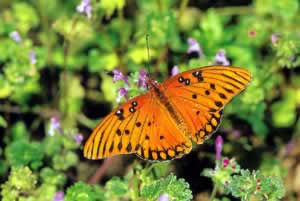 Gulf
Fritillary
Gulf
Fritillary With rather illustrious patterns, the Agrauis vanillae parades brilliant, bright orange color and dark brown or black markings. The most striking patterns are characteristic of males, while females display darker coloration and heavier markings. The Agraulis vanillae is a common, fast-flying, assertive species that is not intimidated by open spaces.
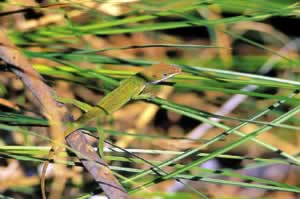 Green
Anole
Green
Anole The mature Anolis carolinensis, often called a chameleon, is a small or medium-sized lizard, reaching about 8 inches. The Green Anole is noted for its ability to change color, turning brown or even grayish when necessary. Color changes are determined by its immediate surroundings and are often unpredictable. Male anoles exhibit an expansive reddish dewlap or throat fan, making it easily distinguishable from female species. These lizards are generally found in suburban, arboreal areas, provided that vegetation and shade are plentiful.
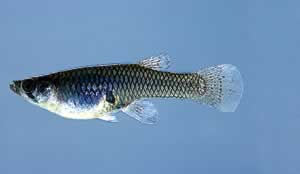 Mosquitofish
Mosquitofish
Robust inhabitants of urban Georgia's fresh water, Gambusia affinis exists primarily due to the prevalence of mosquitoes. It flourishes in ponds and stagnant waters and assists in controlling mosquitoes. These fish display tan to olive superficial tones on the upper side and pale yellow on the underside, and a dark, nearly black bar appears below the eyes. The dorsal and caudal fins are spotted, and their heads are depressed with an oblique mouth. A fascinating characteristic of these impressive fish is their reproductive habits. During mating season, the females will develop black spots on their bellies, announcing they are ready. When it's time, the male anal fin is modified to form the reproductive organ.
 Common
Earthworm
Common
Earthworm Preferring moist soil and somewhat milder temperatures, Lumbricus terrestris is attracted to highly populated areas. Night crawlers, as they are commonly known, are undoubtedly numerous, reaching millions per acre of land. They are usually most active in the spring and fall, hibernating in the winter. The entire makeup of the earthworm, from its outer body to its central nervous system, is fairly simplistic. Its body is composed of about 50 to over 500 similar segments and is commonly recognized for its ability to regenerate itself when necessary. Demonstrating its value to the urban environment, earthworms carry richly organic materials deep into the soil, and deposit digested soil as castings, creating topsoil. Their burrows also help air and water penetrate the soil. This particular hermaphroditic creature produces only a single worm, which reaches maturity after six months and can live up to 10 years.
 Cricket
Cricket
There are over 20,000 existing species nationwide. But more common in southern urban habitats are the Field Cricket, Gryllus pennsylvanicus, and the House Cricket, Acheta domestica, both of which are members of the Gryllidae, or true cricket family. Southerners are probably more familiar with these creatures than they would desire; however, it is only during the winter months that the Field Cricket searches for indoor shelter. Most of these nocturnal species have ultrasensitive hearing organs on the upper part of the fore tibia, that assist them in detecting approaching danger. Unbeknownst to many, only the male is responsible for the distinctive, rather loud chirping or singing. These songs are highly individual and attract females. Most true crickets are omnivores, consuming plant foliage and roots, animal matter, and other insects.
Read and add comments about this page
Go back to previous page. Go to Atlanta's Urban Wildlife contents page. Go to Sherpa Guides home.
[ Previous Topic | Next Topic ]